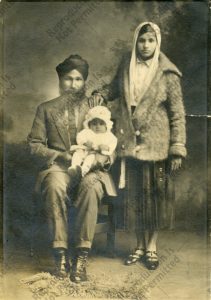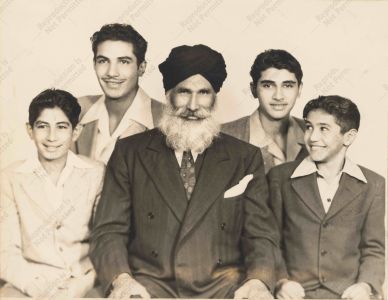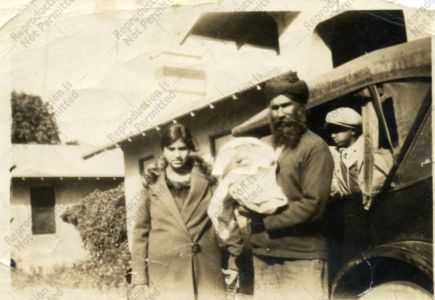
Puna Singh and Nand Kaur with eldest son. Brigham City, Utah, 1924. Courtesy of the Puna Singh and Nand Kaur Family.
Sardar Puna Singh and his wife, Mrs. Nand Kaur, were important historical figures in the early decades of the Punjabi community in California. Theirs was the first Punjabi family in the Yuba City area. Nand Kaur was one of only four women of Punjabi heritage in the area prior to World War II. Both were also ardent supporters of India’s freedom movement. Fortunately, they have given some brief sketches of their experiences and impressions through published interviews which provide invaluable insights into the worldview and lives of early pioneers.
Puna Singh
Sardar Puna Singh (c 1885-July 1974) exemplifies the resilience and perseverance of the early South Asian pioneers. He faced, and eventually overcame, enormous obstacles in building a life for himself and his family in the US. After serving briefly in the British Army in India in his youth, he decided to try his luck in America. He followed the route taken by most of the early pioneers from their homeland to California. Traveling across India from the Punjab to Calcutta, he took a ship to Hong Kong and then boarded another ship bound for Vancouver, Canada. Shortly after arriving in Canada, he headed south to the Sacramento Valley in 1906 where he worked in farm labor and construction on the Southern Pacific Railway Company. He was a passionate supporter of the Gadar (“revolutionary”) movement that aimed to overthrow British rule in India. After attending his first Gadar Party meeting, he recalled: “I was immediately drawn to the organization and thereafter gave both monetary and moral support” (Sikh Sansar, 110). The Stockton Sikh Temple also drew the small Punjabi community that was scattered throughout the West Coast of North America together. The South Asian pioneers who lived far from each other would congregate a few days each year at the Stockton Sikh Temple to celebrate Sikh holidays:
There was generally a feeling of kinship among Indians living here at the time; people were generous with their time, money and labor. Not only did they support the common causes such as the Gurdwaras or the Gadar Party, but they would help each other whenever anyone was in need. (Sikh Sansar, 110)
More
Earning & Losing US Citizenship
Sardar Puna Singh was one of the few Punjabi pioneers who managed to both purchase land and to successfully attain US citizenship before World War II. Unfortunately, he was stripped of both rights in 1923 when the US versus Bhagat Singh Thind Supreme Court decision decided that South Asians were ineligible for US citizenship on racial grounds. Puna Singh described how much he had lost in the wake of the Thind decision: “I had left a farm of my own and now I was working for others. It was a struggle in the beginning and continued to be one until 1929 when I was able to purchase land again” (Sikh Sansar, 110). It wasn’t until 1957 that he decided to regain his US citizenship.
Return to the US & Creating a Family with His wife, Nand Kaur
In 1922, Puna Singh returned to India to marry Nand Kaur. Shortly after marrying, the couple arrived in Seattle via Canada on the Empress of Canada ship on October 8, 1923. After settling in Utah for a few years, they were forced to relocate to Sutter County after Nand Kaur developed snow blindness in the midst of the harsh winter. Puna Singh describes his perseverance during the Great Depression: “The country was on the brink of the economic crisis of the 1930s, yet it was from this time on that I embarked on a dairy and farming enterprise that allowed me to settle down comfortably and make a permanent home.” (Sikh Sansar,110). In Sutter County, they raised seven children (five boys and two girls). In 1929, Puna Singh bought twenty acres of land in his children’s names (it was illegal for him to own land according to California’s Alien Land Laws) where he and his wife established a small dairy farm. Soon after, he bought another 79 acres of land — enough property to provide his family with a home and a lifestyle of relative comfort and security.
Nand Kaur
Nand Kaur (1906 – 1995) was one of only four women of Punjabi heritage who lived in the greater Yuba City area prior to World War II. She found life in the US to be intensely lonely in the beginning until she met other women in the community, first the Mexican wives of Punjabi men and later, other Punjabi women. She adapted to American life quickly as she was soon busy raising her children and helping her husband with the family farm. She was an avid reader who became fluent in English. Her political interests and activism are reflected in a 1994 interview in which she describes Gadar poetry. This poetry was printed in Gadar publications called “Gadar di Gunj” (“The Echo of Revolution”) and formed an integral part of their household. As Nand Kaur shared in her interview, “When I read the poems I felt happy. I thought one day our country would be free and like America it would have all the amenities, making people’s lives easier.” She taught the poetry to her children. She was particularly fond of this lovely Gadar poem:
The path to the heart is through the heart,
I come from the heart to you.
The Gadar workers have strung together choice flowers,
I am a beautiful, fragrant garland.
From the collected breath of the compassionate ones,
I have made a river of nationalism flow.
Selecting pearls from the seven seas,
I have created a precious necklace [of verse].
SOURCES:
Singh, Jane. Interview with Nand Kaur Singh, in Miriam Cooke and Roshni Rostomji-Kerns, Editors, Blood Into Ink: South Asian and Middle Eastern Women Write War (Boulder: Westview, 1994), 175-78).
Singh, Puna. “My Early Years in America,” Sikh Sansar, December 1972.
Less


